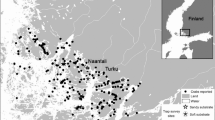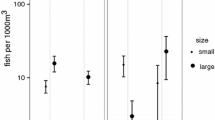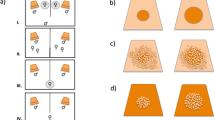Abstract
Resource availability may affect both individual fitness and population demography and the effects can interact. We used two experiments to test how breeding resource abundance and its spatial distribution, combined with female abundance, affected male reproductive behavior, population spawning rate, and embryo development and recruitment in the European bitterling (Rhodeus amarus), a small cyprinid fish that lays its eggs in living unionid mussels. In the first experiment, we found that at the population level the abundance of breeding resources (freshwater mussels) was more important for bitterling recruitment than resource spatial distribution (clumped or regular). In contrast at the individual level, (variability in reproductive success) the spatial distribution of resources was more important, but only when resource abundance was not limiting. Territorial males obtained almost exclusive access to fertilizations when resources were abundant and distributed regularly, but were unable to defend large clusters of resources (when rival abundance was always high) and abandoned territoriality. Surprisingly, territorial males remained aggressive and successfully defended their territories when resources were grouped into a single cluster, but at a low abundance. In the second experiment, more rapid embryo development and larger juvenile body size at the end of the growing season was detected at high resource abundance and low female abundance, indicating that early hatched juveniles survived better and hence investment in offspring production early in the season yields a higher fitness pay-offs. The abundance of females in spawning condition was the best overall predictor of the intensity of male reproductive behavior in both experiments.




Similar content being viewed by others

References
Ahnesjö I (1996) Apparent resource competition among embryos in the brood pouch of a male pipefish. Behav Ecol Sociobiol 38:167–172
Aldridge DC (1999) Development of European bitterling in the gills of freshwater mussels. J Fish Biol 54:138–151
Barrett ELB, Hunt J, Moore AJ, Moore PJ (2009) Separate and combined effects of nutrition during juvenile and sexual development on female life-history trajectories: the thrifty phenotype in a cockroach. Proc R Soc Lond B. doi:10.1098/rspb.2009.0725
Beekey MA, Karlson RH (2004) Apparent sibling rivalry in the freshwater fingernail clam Sphaerium striatinum. Behav Ecol Sociobiol 57:17–22
Birkhead TR, Fletcher F, Pellatt EJ (1999) Nestling diet, secondary sexual traits and fitness in the zebra finch. Proc R Soc Lond B 266:385–390
Cargnelli LM, Gross MR (1996) The temporal dimension in fish recruitment: birth date, body size, and size-dependent survival in a sunfish (bluegill: Lepomis macrochirus). Can J Fish Aquat Sci 53:360–367
Cohen J (1988) Statistical power analysis for the behavioral sciences. Hillsdale, New Jersey
Dubois FD, Giraldeau LA (2005) Fighting for resources: the economics of defense and appropriation. Ecology 86:3–11
Emlen ST, Oring LW (1977) Ecology, sexual selection, and the evolution of mating systems. Science 197:215–223
Forchhammer MC, Clutton-Brock TH, Lindström J, Albon SD (2001) Climate and population density induce long-term cohort variation in a northern ungulate. J Anim Ecol 70:721–729
Gauthier G, Smith JNM (1987) Territorial behaviour, nest-site availability, and breeding density in buffleheads. J Anim Ecol 5:171–184
Grant JWA, Gaboury CL, Levitt HL (2000) Competitor-to-resource ratio, a general formulation of operational sex ratio, as a predictor of competitive aggression in Japanese medaka (Pisces: Oryziidae). Behav Ecol 11:670–675
Griffiths D, Kirkwood RC (1995) Seasonal variation in growth, mortality and fat stores of roach and perch in Lough Neagh, Northern Ireland. J Fish Biol 47:537–554
Held J, Manser T (2005) A PDA-based system for online recording and analysis of concurrent events in complex behavioral processes. Behav Res Methods 37:155–164
Hunt J, Brooks R, Jennions MD (2005) Female mate choice as a condition-dependent life-history trait. Am Nat 166:79–92
Jones AG, Walker D, Kvarnemo C, Lindstrom K, Avise JC (2001) How cuckoldry can decrease the opportunity for sexual selection: data and theory from a genetic parentage analysis of the sand goby, Pomatoschistus minutus. PNAS 98:9151–9156
Kamler E (1992) Early life history of fish: an energetics approach. Chapman and Hall, London
Kirjasniemi M, Valtonen T (1997) Size-dependent over-wintering mortality of young-of-the-year roach, Rutilus rutilus. Environ Biol Fish 50:451–456
Kitamura J (2005) Factors affecting seasonal mortality of rosy bitterling (Rhodeus ocellatus kurumeus) embryos on the gills of their host mussel. Popul Ecol 47:41–51
Lindström K (2001) Effects of resource distribution on sexual selection and the cost of reproduction in sand gobies. Am Nat 158:64–74
Mills SC, Reynolds JD (2002a) Host species preferences by bitterling, Rhodeus sericeus, spawning in freshwater mussels and consequences for offspring survival. Anim Behav 63:1029–1036
Mills SC, Reynolds JD (2002b) Mussel ventilation rates as a proximate cue for host selection by bitterling, Rhodeus sericeus. Oecologia 131:473–478
Mills SC, Reynolds JD (2003) Operational sex ratio and alternative reproductive behaviours in the European bitterling, Rhodeus sericeus. Behav Ecol Sociobiol 54:98–104
Nakagawa S, Cuthill IC (2007) Effect size, confidence interval and statistical significance: a practical guide for biologists. Biol Rev Camb Philos Soc 82:591–605
Newton I (1994) The role of nest sites in limiting the numbers of hole-nesting birds—a review. Biol Conserv 70:265–276
Noël MV, Grant JWA, Carrigan JG (2005) Effects of competitor-to-resource ratio on aggression and size variation within groups of convict cichlids. Anim Behav 69:1157–1163
Payne AG, Smith C, Campbell AC (2002) Filial cannibalism improves survival and development of beaugregory damselfish embryos. Proc R Soc Lond B 269:2095–2102
Pröhl H, Berke O (2001) Spatial distributions of male and female strawberry poison frogs and their relation to female reproductive resources. Oecologia 129:534–542
Przybylski M, Reichard M, Spence R, Smith C (2007) Spatial distribution of oviposition sites determines variance in the reproductive rate of European bitterling (Rhodeus amarus). Behaviour 144:1403–1417
Reichard M, Jurajda P, Smith C (2004a) Male-male interference competition decrease spawning rate in the European bitterling (Rhodeus sericeus). Behav Ecol Sociobiol 56:34–41
Reichard M, Smith C, Jordan WC (2004b) Genetic evidence reveals density-dependent mediated success of alternative mating tactics in the European bitterling (Rhodeus sericeus). Mol Ecol 13:1569–1578
Reichard M, Bryja J, Ondračková M, Dávidova M, Kaniewska P, Smith C (2005) Sexual selection for male dominance reduces opportunities for female mate choice in the European bitterling (Rhodeus sericeus). Mol Ecol 14:1533–1542
Reichard M, Przybylski M, Kaniewska P, Liu H, Smith C (2007) A possible evolutionary lag in the relationship between freshwater mussels and European bitterling. J Fish Biol 70:709–725
Reichard M, Smith C, Bryja J (2008) Seasonal change in the opportunity for sexual selection. Mol Ecol 17:642–651
Reichard M, Ondračková M, Bryjová A, Smith C, Bryja J (2009) Breeding resource distribution affects selection gradients on male phenotypic traits: experimental study on lifetime reproductive success in the bitterling fish (Rhodeus amarus). Evolution 63:377–390
Shuster SM, Wade MJ (2003) Mating systems and strategies. Princeton University Press, Princeton
Smith C, Douglas A, Jurajda P (2002) Sexual conflict sexual selection and sperm competition in the spawning decisions of bitterling (Rhodeus sericeus). Behav Ecol Sociobiol 51:433–439
Smith C, Reichard M, Jurajda P, Przybylski M (2004) The reproductive ecology of the European bitterling (Rhodeus sericeus). J Zool 262:107–124
Smith C, Reynolds JD, Sutherland WJ (2000a) The population consequences of reproductive decisions. Proc R Soc Lond B 267:1327–1334
Smith C, Reynolds JD, Sutherland WJ, Jurajda P (2000b) Adaptive host choice and avoidance of superparasitism in the spawning decisions of bitterling (Rhodeus sericeus). Behav Ecol Sociobiol 48:29–35
Smith C, Rippon K, Douglas A, Jurajda P (2001) A proximate cue for oviposition site choice in the bitterling (Rhodeus sericeus). Freshwat Biol 46:903–911
Spence R, Smith C (2005) Male territoriality mediates density and sex ratio effects on oviposition in the zebrafish, Danio rerio. Anim Behav 69:1317–1323
Sutherland WJ (1996) From individual behaviour to population ecology. Oxford University Press, Oxford
Wootton RJ (1998) Ecology of teleost fishes. Kluwer Academic Publisher, Dordrecht
Acknowledgments
The study was supported by Czech Science Foundation (206/09/1163). MR holds a license for conducting experimental work on vertebrates and all experiments complied with current legal regulations in the Czech Republic. MR and CS conceived and designed the research. MK and CS collected the data, MR and MK analyzed data, and MR drafted the paper. All authors contributed to writing.
Author information
Authors and Affiliations
Corresponding author
Additional information
Communicated by: C. St. Mary.
Rights and permissions
About this article
Cite this article
Konečná, M., Smith, C. & Reichard, M. Population and individual consequences of breeding resource availability in the European bitterling (Rhodeus amarus). Behav Ecol Sociobiol 64, 1069–1079 (2010). https://doi.org/10.1007/s00265-010-0921-4
Received:
Revised:
Accepted:
Published:
Issue Date:
DOI: https://doi.org/10.1007/s00265-010-0921-4



